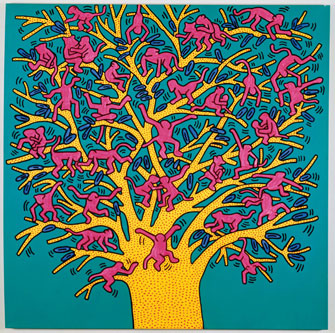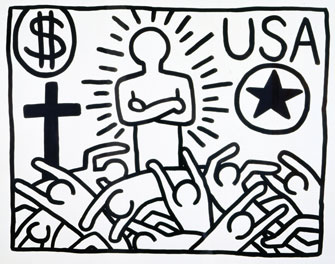Red Haring Sends
Strong Political Message

“The Tree of Monkeys” (1984). © Keith Haring Foundation
Known for its bold lines, vivid colors and violent imagery, Keith Haring’s art has always packed a punch. It has also always been political, as demonstrated by a major new two-part retrospective currently being shown at the Musée d’Art Moderne de la Ville de Paris and the Centquatre Gallery. The show brings together some 250 Haring works, many of which are instantly recognizable, despite the 23 years that have elapsed since the artist’s death to AIDS in 1990.
The first part of the show, at the Musée d’Art Moderne, consists mostly of two-dimensional pieces, biographical material and small sculptures, while its extension on the other side of town features a number of Haring’s monumental works. Despite the distance between the two sections, they really are worth seeing together on the same day if possible, coming together to give a remarkably complete vision of the artist’s creative priorities, pleasures and principles.
Borrowed from public and private collectors, many of the works have not seen the inside of a gallery since Haring’s death. Visitors expecting a slideshow of the artist’s famous motifs will not be disappointed: from the beginning of the exhibition, we are pitched into an interminable labyrinth of weapons, skulls and feral dogs. The human figure, evoked by a thick strip that recalls the chalk outlines daubed around crime-scene corpses, is particularly ubiquitous, denoting the strong influence exerted upon Haring by the comic-book genre. There is much more, however – his innovative reinterpretation of old artistic conventions, for one thing, expressed perhaps most memorably in “Sarcophagus,” a life-sized mummy, covered head-to-toe in graffiti.
Haring drew constantly and compulsively, on anything and everything, from an early age. Visitors are treated to an unusually broad range of materials, from the usual canvas and paper to tarpaulin and pipes. In a clinically lit room, we discover a number of his subway graffiti pieces, created illicitly in New York during the 1980s. The nobility of Haring’s goal – to bring his art and its messages to the people – is quietly ironized by the inclusion of photographs of members of the public, bemused by their confrontation with Haring’s strange drawings.
Anxious to connect to their visitors, many modern-day retrospectives re-politicize their chosen artist, extrapolating polemical messages from pieces that were probably never made with such ideas in mind. In Haring’s case, however, no political Botox is required – a self-declared activist, he used his art as a

“Untitled” (1982). © Keith Haring Foundation
way of demanding major social change. His enraged dogs and perforated humans come together at unexpected moments to communicate grave messages, including the perils of blind religiosity, the dangers of consumer capitalism and the realities of climate change.
Most movingly, toward the end of his life, Haring’s uncompromising line takes on the burden of his own mortality, as in the diptych made for James Ensor (untitled), which shows a skeleton urinating on plants. In the following panel, it springs back to life, standing as a monument to the broadness of Haring’s mind, even at so late a stage in his illness.
Haring undeniably took a “political line,” but it is an invigorating one. While the show is perhaps a little too comprehensive – it degenerates, at times, into repetitiveness – it is well worth a visit.
Musée d’Art Moderne de la Ville de Paris: 11, avenue du Président Wilson, 75116 Paris. Métro: Alma-Marceau or Iéna. Tel.: 01 53 67 40 00. Open Tuesday-Sunday, 10 a.m.-6 p.m. (Thursday until 10 p.m.). Closed on public holidays. Admission: €11. Through Aug. 18, 2013. www.mam.paris.fr
Reader reaction: Click here to respond to this article (your response may be published on this page and is subject to editing).
Please support Paris Update by ordering books from Paris Update’s Amazon store at no extra cost. Click on your preferred Amazon location: U.K., France, U.S.
More reviews of Paris art shows.
© 2013 Paris Update
